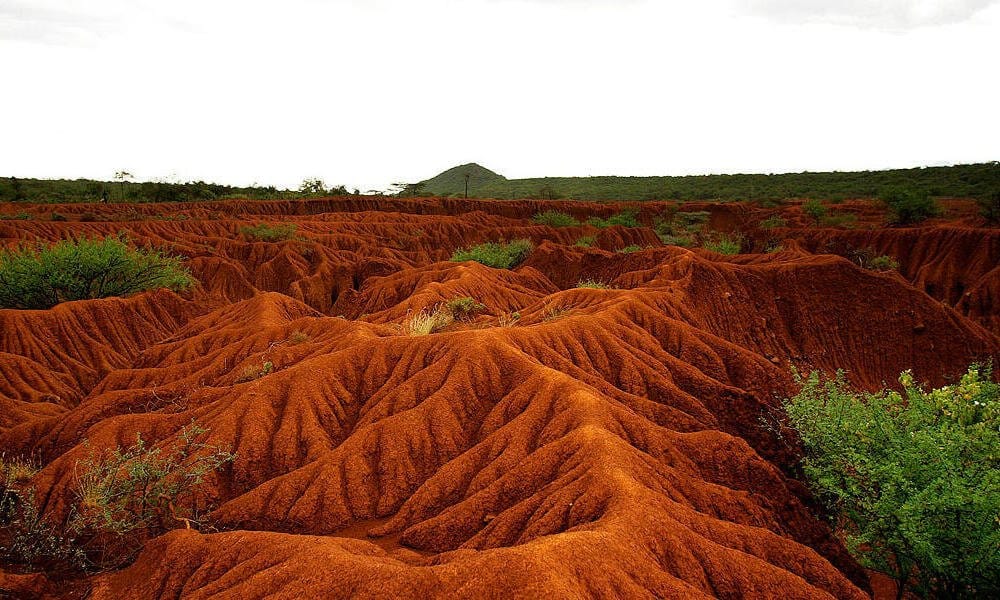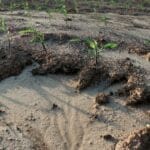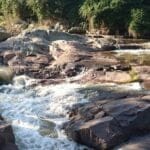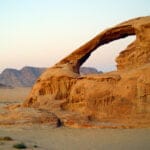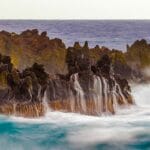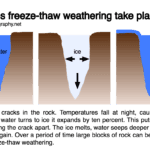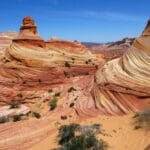Let’s dig into the world of erosion! It’s not just about dirt washing away. It’s a force that’s been carving our planet for ages. Join us as we explore how erosion works, how it affects our environment, and the incredible stories it reveals about our planet’s past, present, and future. Get ready to uncover the hidden secrets of the forces that shape our Earth!
Another Name for Erosion
You know how things wear down over time? Like your favorite pair of jeans getting thin in the knees? That’s essentially erosion, but instead of denim, it’s happening to land, rock, and even metal!
We often call this process “erosion,” but it has many other names, each providing a different perspective on how things break down:
- Deterioration: Like an old wooden fence slowly rotting away.
- Wearing Away: A gradual scraping or rubbing of a surface, like rocks in a riverbed.
- Corrosion: Rust slowly eating away at metal, weakening it over time.
- Destruction: A powerful force reshaping landscapes, such as coastal erosion from a storm surge.
- Disintegration: Something crumbling into smaller pieces, like cliffs battered by waves.
Erosion’s reach extends beyond the tangible. It can also affect things we can’t even touch, like a community’s spirit or a person’s hope. In these cases, words like “weakening” or “depletion” describe the gradual loss.
Understanding the many faces of this natural force helps us appreciate its power and find better ways to protect the things we value. Scientists are constantly studying erosion to predict and mitigate its effects. It’s a complex process, and much remains unknown. But, by recognizing the different ways things break down, we can start to find solutions to keep our world – both physical and intangible – strong.
What is Another Word for Erosion?
Let’s unlock the vocabulary of erosion, exploring alternative terms that shed light on this natural phenomenon:
- Denudation: Imagine stripping away layers, like peeling an onion. Denudation is the grand removal of surface material – soil, rock, and more – through processes like abrasion, weathering, and, of course, erosion.
- Exfoliation: Just as skin can become dry and flaky, the Earth’s surface experiences something similar. Exfoliation is the shedding of Earth’s outer layers, with bits and pieces flaking or peeling away due to wind, sun, or freeze-thaw cycles.
- Weathering: This term describes the gradual breakdown of rocks, minerals, and other materials due to exposure to the elements – rain, wind, temperature swings, and even lichens.
- Attrition: Picture rocks in a riverbed, constantly bumping and grinding against each other, slowly wearing each other down. That’s attrition – the wearing down of surfaces through constant contact and friction.
- Corrosion: This often-invisible process involves chemical reactions that break down a material. Corrosion is frequently associated with metal, like rusty cars or bridges, but it can affect various materials.
Key Takeaways:
- Erosion is the gradual wearing away or destruction of a material’s surface, a slow and steady process with undeniable impact.
- Synonyms like denudation, exfoliation, weathering, attrition, and corrosion highlight different aspects of this natural phenomenon.
- Understanding these nuances provides a deeper appreciation for erosion’s impact on our planet, crucial for protecting our ecosystems, coastlines, and cultural heritage sites.
This is merely the tip of the iceberg! Research in this field is constantly evolving, revealing new insights into the complex processes shaping our planet.
What is Erosion Known As?
Erosion, Mother Nature’s way of slowly reshaping the Earth, isn’t a solo act. It’s a team effort, with different players taking turns:
The Erosion Crew:
- Water: The constant flow of a river can wear down even the most solid rock over time. Raindrops, while seemingly insignificant, dislodge soil particles, especially on hillsides.
- Wind: A sandstorm vividly illustrates wind erosion in action! Wind picks up tiny bits of sand and dust, carving out rock formations and creating sand dunes over time.
- Ice: Glaciers, though slow-moving, are incredibly powerful. Their immense weight carves out valleys and leaves behind piles of rock and debris called moraines.
- Gravity: Ever-present gravity pulls things downwards. If a slope becomes unstable, gravity can cause landslides and avalanches, moving vast amounts of earth and rock in an instant.
Different Flavors of Erosion:
- Water Erosion: Rain, rivers, streams, and ocean waves all shape coastlines and carve out canyons.
- Wind Erosion: Most prevalent in deserts and beaches where vegetation is sparse, wind erosion results in dust storms and shifting sands.
- Glacial Erosion: Taking place over thousands of years, glacial erosion yields dramatic results – towering peaks, deep valleys, and U-shaped glacial troughs.
- Coastal Erosion: The relentless battle between land and sea! Crashing waves wear away cliffs and pull sand from beaches, constantly reshaping coastlines.
Unanswered Questions:
Scientists are continually studying erosion and its effects, seeking answers to complex questions:
- How do different types of erosion interact with each other?
- How does climate change affect erosion rates?
- What are the long-term impacts of erosion on human societies?
Unraveling the mysteries of this powerful force that shapes our planet is an ongoing endeavor.
What is Another Word for Eroding?
Erosion – the subtle process where natural forces gradually wear away at the Earth’s surface – has many synonyms, each adding a layer of understanding to this natural phenomenon.
Consider the word corrosion. Like rust eating away at metal, corrosion vividly illustrates the gradual destruction of a material. Depletion, often used in the context of dwindling resources, emphasizes the gradual reduction or consumption of something over time. Detrition suggests a wearing down or grinding away, much like how time slowly erases memories.
Erosion is a chain reaction involving weathering, transportation, and deposition. Weathering, the initial step, weakens rocks, breaking them into smaller pieces. Wind, water, or ice (our transportation crew) then carry these fragments away. Finally, deposition occurs – the transported material settles, potentially forming new landforms.
The Grand Canyon stands as a breathtaking testament to erosion’s power. Over millions of years, the Colorado River has carved its path through rock, showcasing the awe-inspiring forces at play. Erosion’s influence extends beyond such dramatic displays, subtly shaping our landscapes, from rolling hills to sandy beaches.
However, erosion is a double-edged sword. While it creates breathtaking landscapes, it can also lead to soil loss, hindering agriculture. Erosion also damages buildings and roads and can pollute waterways.
Erosion is more than a scientific term; it’s a powerful force shaping our world – sometimes beneficial, sometimes destructive.
What is Another Name for Erode?
“Denudation” is a less common but equally apt synonym for “erode.” When something erodes, it wears away bit by bit. Similarly, denudation refers to the Earth’s surface slowly being worn down by natural forces.
This “wearing down” involves several stages:
- Detachment: Bits of soil, rock, or tiny particles loosen.
- Transportation: Wind, water, or ice pick up these loose bits and move them.
- Deposition: The transported material is deposited, perhaps further down a river, at the bottom of a hill, or out at sea.
Water erosion, the most common type, is evident in the way rivers carve shapes in stone. Wind erosion is prominent in areas with little vegetation, creating sand dunes as the wind pushes sand around. Glaciers, massive rivers of ice, exert immense pressure as they move, carving out valleys and pushing around huge amounts of earth. Finally, gravity erosion – the most straightforward of the bunch – simply involves things rolling downhill!
Erosion is more than just a scientific concept; it has tangible consequences. Topsoil erosion makes it challenging to grow crops. It can also increase the likelihood of floods and landslides.
Therefore, erosion, or denudation, is a significant process that scientists constantly strive to understand better.
What is the Second Name of Erosion?
While “erosion” is the more common term, its lesser-known alias, “denudation,” deserves equal attention. Think of it this way: erosion is the action, denudation is the result. Denudation encompasses the entire process of wearing down and reshaping the Earth’s surface.
While water, wind, and ice are often credited with erosion, denudation takes a broader perspective. It considers all contributing factors to the Earth’s surface transformation, including chemical weathering (like acid rain dissolving rock) and the impact of living organisms. If erosion is a powerful tool, denudation is the skilled artisan, thoughtfully sculpting the Earth’s surface over time.
The rate of denudation, or how quickly the landscape changes, depends on various factors. Climate plays a significant role: areas with abundant rain and dramatic temperature swings experience faster denudation. Rock type is also crucial; some rocks are incredibly resistant, while others crumble easily. Vegetation acts as a protective barrier; a dense forest can significantly slow down erosion, while exposed land is left vulnerable.
Scientists are still working to fully comprehend denudation, developing new techniques to precisely measure erosion rates and utilizing computer models to predict future landscape changes. This intriguing field of study has significant implications for managing natural resources and predicting climate change impacts.
Which is Another Example of Erosion?
Erosion, the Earth’s slow-motion makeover artist, carves out canyons and smooths coastlines. While wind and water are known to erode even the toughest rocks, the methods they employ are surprisingly diverse.
Consider a rainstorm. It’s not just the water’s force, but the impact of each raindrop, creating tiny dents in the soil – splash erosion. Muddy puddles after a downpour are evidence of this process.
Rainwater flowing downhill, especially on bare land, creates miniature rivers carrying away soil particles. Initially nearly invisible, this sheet erosion spreads like a sheet before forming larger flows.
As water gains momentum, it carves small channels into hillsides – rill erosion, like nature drawing lines in the dirt. When these rills deepen into gullies, it indicates significant gully erosion.
Wind erosion is another powerful force. On a windy day at the beach, observe how the wind picks up loose sand and blasts it against rocks, slowly wearing them down. Over time, this process can create stunning rock formations.
Scientists continually study these different types of erosion to understand their mechanisms and protect our planet from their potentially destructive effects. It’s fascinating how something as simple as wind or water can dramatically impact the world around us.
Erosion is the process in which earth materials are removed from the Earth’s surface. What is erosion? is a natural process that occurs over time, but human activities can accelerate it. Coastal erosion is a type of erosion that occurs along coastlines. Which is one way that waves erode coastlines? One way is by hydraulic action, the process of waves crashing against the coast and breaking down rock and soil. Erosion can cause various changes to the landscape, including the formation of cliffs, beaches, and sand dunes. What types of changes does erosion cause? These include changes to the shape of the land, the loss of soil, and the creation of new landforms.
